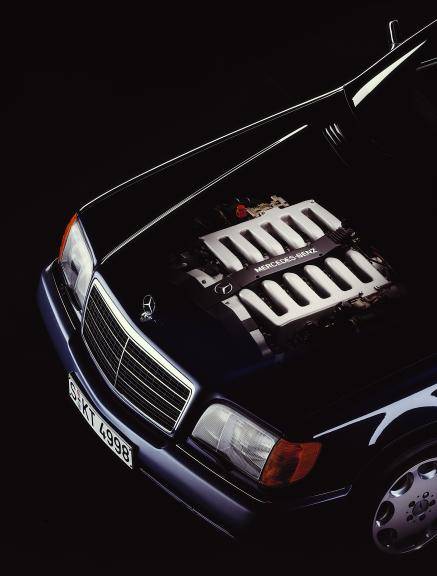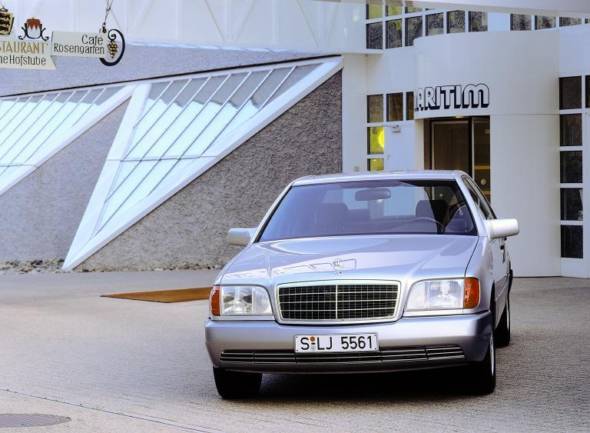Mercedes W140 S-Class 1992 – 1998

In March 1991 a new generation of the S-Class (internal designation: series 140) was presented on the Geneva Automobile Salon.

The design of the bodywork took as its model the traditional styling elements typical of Mercedes-Benz and, in so doing, became another member of the passenger-car model family designed very homogeneously.

Like it was already the case with the 129 series SL models, in keeping the traditional basic shape the cooling mask as the characteristic feature of the new S-Class was newly interpreted in terms of style.

With this variant of a classic topic called “Plakettenkühler” (“tag radiator”) the radiator cowling with its considerably thinner chrome frame was integrated organically into the bonnet, the Mercedes-star was not placed on the radiator’s mask but put slightly backwards on the bonnet.

Overall the development of the design concept of the new S-Class had been aimed at realizing a high degree of aerodynamic quality simultaneaously considering maximum suitability for everyday life.

Like it had been the case with the predecesor models of series 126 and generations of Mercedes-Benz top-class ranges, there was – apart from the normal version -a variant with long wheelbase and the extension by 100 mm only enlarged the rear footwell.

As for the engines, four aggregates for the domestic market were available for the time being with only the 5.0-liter 4-valve V8-engine M 119 being an old acquaintance.

Like in the 500 E, an improved version whose fully electronic injection system Bosch “LH-Jetronic” was controlled via a hot-film air-mass sensor was used here.

The other three engines had been newly developed: The 4.2-liter 4-valve V8-engine had been developed from the time-tested 4.2-liter 2-valve engine according to the model of the 5.0-liter unit, and the 6-cylinder in-line engine with 3.2 liter displacement was based on the 3.0-liter 4-valve unit introduced two years earlier.
By the way the following interesting detail should be mentioned: the type designations of the 3.2-liter and 4.2-liter models did not exactly reflect the displacement as it is usual.

For reasons of homogeneity the designations 300 SE/SEL and 400 SE/SEL were chosen instead.
A completely new constructed vehicle was the 6.0-liter V12-engine not only representing the first passenger car 12-cylinder of Mercedes-Benz produced in series but, at the same time, went down in history as the most powerful Mercedes-Benz passenger car-engine with a nominal performance of 300 kW (408 hp).
The nominal torque amounted to 580 Nm and exceeded the 500-Nm limit already at 1,600 rpm.

Like the 6-cylinder and the two V8-engines the 12-cylinder was equipped with 4-valve technology, inlet camshafts adjustable in operation as well as electronic injection system with hot-film air-mass sensoring.
With all engines the minimization of the pollutant emissions and the fuel consumption was the prime target.
The new fully electronic ignition calculates the optimum ignition point from overall 300 ignition maps doing it separately for each cylinder and adjusted to the knock limit.

The M 120 was the only 12-cylinder engine in the world to be fitted with this cylinder-selective anti-knock control.
This system was absolutely vital to attain the high compression-ratio of 10:1 necessary for an optimized use of consumption.

Completely novel, too, was the engine- and driving management with all controlling modules communicating with one another via a common data channel.

With that the controlling devices can get active together. This is used among other things for the fast heating of the catalytic converters after the cold start of the engine, moreover for the anti-slid control and for the new engine.

Drag torque control securing the driving stability when the foot is taken off the accelerator even on a slippery road.

With a volume of 7 liters the V12 was equipped with the largest catalytic converter-system for passenger cars in the world.
It was dimensioned in such a way that the consumption of fuel was not increased an a long-term stability was ensured.

Through a novel concept of double wall and three-layer exhaust manifolds and likewise double wall pipes the ceramic-catalytic converters embedded in a heat insulated soaking mat reached the optimized operating temperature in an extremely short time.

Apart from the exhaust optimization and reduction there were other details in the S-Class making it the pioneer of an environmentally compatible automobile production.

The S-Class was the first vehicle of the era of the cfc-free automobiles and pointed the way in terms of recycling.: The plastic components were not only completely reusable and clearly marked but, moreover, were already produced in many cases by using regranulate.

In 1992 the S-Class received the “Stratospheric Ozone Protection Award” – the environment prize of the American “Environmental Protection Agency”.
Apart from the reduction of fuel consumption and other environmental goals, the development of the new S-Class also aimed at perfecting comfort and safety.

In this respect, one of many features was the careful conception and adjustment of the suspension.

New double wishbone front suspension was introduced, mounted on a subframe in order to reduce vibrations.
Rear suspension was derived from the multi-link rear suspension of the other Mercedes-Benz car series, although wheel control was thoroughly revised and adapted to the special requirements of the S-Class.

Aspects of active safety on the 140 series S-Class included extremely straight running on uneven roads, low sensitivity to side winds, precise steering and negligible changes in handling with different loads.
A fundamental innovation on the 8-cylinder and twelve-cylinder models was the brake system, with more brake force going to the rear axle.

The advantage of this is reduced wear of the front brake disks giving them a longer lifetime.
Passive safety features included numerous bodywork details giving significantly higher protection in the case of a crash than the high standard already achieved by the previous S-Class.

A lot of attention was also paid to reducing injuries or damage to other participants in an accident. Both electric windows and central locking were part of the standard equipment.

For the first time on a car double-glazing with sealed units was used, enhancing both safety and comfort.
Visibility was improved by preventing the windows from steaming up or icing up, heat and sound insulation were improved, as were streamlining and wind noise.

Two further design details were included to assist manoeuvring – foldable door mirrors and telescopic reversing rods.

The door mirrors could be folded back electrically by means of a switch on the central console to make it easier to park in narrow spaces.

In order to judge better the distance of obstacles while reversing a telescopic rod was fitted to each rear corner of the bodywork.
These 65 mm long chrome rods automatically emerged 2 seconds after engaging reverse gear and disappeared 8 seconds after shifting out of reverse gear.

At the Paris Motor Show in October 1992 the 300 SE 2.8 and 300 SD were presented, two lower-price economical versions of the S-Class.
The 300 SD had been exported to the USA since October 1991, but it was the first Diesel S-Class to go on sale in Germany.

The 300 SD had a 150 hp version of the 3.5-liter 6-cylinder engine with exhaust turbocharging that had already been used in the previous model of the 126 series.
The 300 SE 2.8 had a 6-cylinder 4-valve engine, also from the M 104 engine family. The newly developed 2.8-liter engine was also introduced in the 124 series at the same time.
Revised versions of the 8-cylinder and 12-cylinder engines were also shown in Paris.

A richening of the fuel/air mixture under full throttle had been eliminated, resulting in a little less power but much lower emissions.
In June 1993 the model designations were changed and made similar to those of the other car series.

The “S” now came before a three-digit figure which denoted the engine’s cubic capacity and suffixes such as “E”, “D” and “L” disappeared.
Thus the 500 SE became the S 500, and the 600 SEL was now called the S 600 long wheelbase.

Apart from these formal changes both 3.2-liter models now had improvements. A new version of the engine was used with improved inlet manifold and fuel injection system resulting in slightly better performance and a reduction in fuel consumption of 7.5 %.

Minor styling improvements to the S-Class sedans were to be seen at the Geneva Motor Show in March 1994.




